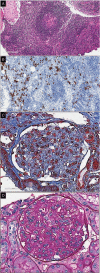A life-threatening case of TAFRO syndrome with dramatic response to tocilizumab, rituximab, and pulse steroids: The first case report in Latin America
- PMID: 28353560
- PMCID: PMC5380244
- DOI: 10.1097/MD.0000000000006271
A life-threatening case of TAFRO syndrome with dramatic response to tocilizumab, rituximab, and pulse steroids: The first case report in Latin America
Abstract
Rationale: This is the report of the first case of TAFRO syndrome (Thrombocytopenia, Anasarca, myelofibrosis, Renal dysfunction, Organomegaly) in Latin America.
Patient concerns: The patient was a 61-year-old white woman of Ashkenazi Jewish descent, who presented with a history of 8 days of nausea, vomiting, and fever; severe pitting edema in both legs, ascites, splenomegaly, and palpable axillary lymph nodes.
Diagnoses: Abdominal computed tomography (CT) showed bilateral pleural effusion and retroperitoneal lymph node enlargement.
Interventions: Anasarca and worsening of renal function led to admission to the intensive care unit (ICU) with multiple organ failure, requiring mechanical ventilation, vasopressor medications, and continuous renal replacement therapy (CRRT). Diagnosis of TAFRO syndrome was made on day 18 after admission, based on clinical findings and results of bone marrow and lymph node biopsies. She was treated with methylprednisolone, tocilizumab, and rituximab. One week after the first tocilizumab dose, she had dramatic improvements in respiratory and hemodynamic status, and was weaned from ventilator support and vasopressor medications.
Outcomes: After 2 weeks of therapy, CRRT was switched to intermittent hemodialysis. On day 46, the patient was discharged from the ICU to the general ward, and 3 months after admission, she went home.
Lessons: Provided the interleukin-6 measurement is available, this approach is suggested in cases of TAFRO syndrome, in order to customize the treatment.
Conflict of interest statement
The authors have no conflicts of interest.
Figures


Similar articles
-
Kidney biopsy findings in two patients with TAFRO syndrome: case presentations and review of the literature.BMC Nephrol. 2020 Nov 23;21(1):499. doi: 10.1186/s12882-020-02119-7. BMC Nephrol. 2020. PMID: 33225930 Free PMC article. Review.
-
Unexplained cause of thrombocytopenia, fever, anasarca and hypothyroidism: TAFRO syndrome with thrombotic microangiopathy renal histology.BMJ Case Rep. 2020 Jun 30;13(6):e234155. doi: 10.1136/bcr-2019-234155. BMJ Case Rep. 2020. PMID: 32606113 Free PMC article.
-
Tocilizumab-resistant TAFRO Syndrome Complicated by Type II Respiratory Failure.Intern Med. 2017 Dec 1;56(23):3249-3254. doi: 10.2169/internalmedicine.8360-16. Epub 2017 Oct 11. Intern Med. 2017. PMID: 29021431 Free PMC article.
-
Thrombocytopenia, Anasarca, Fever, Reticulin Fibrosis/Renal Failure, and Organomegaly (TAFRO) Syndrome with Bilateral Adrenal Hemorrhage in Two Caucasian Patients.Am J Case Rep. 2020 Apr 6;21:e919536. doi: 10.12659/AJCR.919536. Am J Case Rep. 2020. PMID: 32249274 Free PMC article.
-
Tocilizumab for the treatment of TAFRO syndrome: a systematic literature review.Ann Hematol. 2020 Nov;99(11):2463-2475. doi: 10.1007/s00277-020-04275-0. Epub 2020 Sep 22. Ann Hematol. 2020. PMID: 32964342
Cited by
-
Pathological findings of progressive renal involvement in a patient with TAFRO syndrome.CEN Case Rep. 2019 Nov;8(4):239-245. doi: 10.1007/s13730-019-00400-9. Epub 2019 May 10. CEN Case Rep. 2019. PMID: 31077056 Free PMC article.
-
Intracranial Hemorrhage in a Patient with TAFRO Syndrome Treated with Cyclosporine A and Rituximab.Medicina (Kaunas). 2021 Sep 16;57(9):971. doi: 10.3390/medicina57090971. Medicina (Kaunas). 2021. PMID: 34577894 Free PMC article.
-
Pathophysiology, Treatment, and Prognosis of Thrombocytopenia, Anasarca, Fever, Reticulin Fibrosis/Renal Failure, and Organomegaly (TAFRO) Syndrome: A Review.Curr Issues Mol Biol. 2024 Oct 9;46(10):11255-11269. doi: 10.3390/cimb46100668. Curr Issues Mol Biol. 2024. PMID: 39451548 Free PMC article. Review.
-
TAFRO Syndrome in Caucasians: A Case Report and Review of the Literature.Front Med (Lausanne). 2017 Sep 22;4:149. doi: 10.3389/fmed.2017.00149. eCollection 2017. Front Med (Lausanne). 2017. PMID: 29018798 Free PMC article.
-
A Case of Repeated TAFRO Syndrome-Like Symptoms and Retroperitoneal Hemorrhage in a Patient With Sjögren Syndrome.Cureus. 2020 Dec 19;12(12):e12175. doi: 10.7759/cureus.12175. Cureus. 2020. PMID: 33489586 Free PMC article.
References
-
- Fajgenbaum DC, van Rhee F, Nabel CS. HHV-8-negative, idiopathic multicentric Castleman disease: novel insights into biology, pathogenesis, and therapy. Blood 2014;123:2924–33. - PubMed
-
- Suda T, Katano H, Delsol G, et al. HHV-8 infection status of AIDS-unrelated and AIDS-associated multicentric Castleman's disease. Pathol Int 2001;51:671–9. - PubMed
-
- Beck JT, Hsu SM, Wijdenes J, et al. Brief report: alleviation of systemic manifestations of Castleman's disease by monoclonal anti-interleukin-6 antibody. N Engl J Med 1994;330:602–5. - PubMed
-
- Iwaki N, Fajgenbaum DC, Nabel CS, et al. Clinicopathologic analysis of TAFRO syndrome demonstrates a distinct subtype of HHV-8-negative multicentric Castleman disease. Am J Hematol 2016;91:220–6. - PubMed
-
- Yamaga Y, Tokuyama K, Kato T, et al. Successful treatment with cyclosporin A in tocilizumab-resistant TAFRO syndrome. Intern Med 2016;55:185–90. - PubMed
Publication types
MeSH terms
Substances
Supplementary concepts
LinkOut - more resources
Full Text Sources
Other Literature Sources

